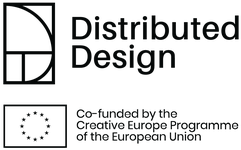Cities are potential engines of the transition towards a circular economy. The City of Amsterdam is one of the early adopters of the circular economy concept at city level. Closed loops, value generation, innovative business models, and modular designs – those are not only principles to guide the transition to circular cities, but also principles distributed designers have been working with for years. In our series Distributed Design for Circular Cities, we introduce you to some of the creative talents making an impact. In this episode, we interview Marije Remigius about Fiction Factory’s circular ambitions.
Can you give us a description of your project?
At Fiction Factory we produce custom-made interiors for businesses from a diversity of materials. For two years we have been producing with circular engineering principles and developing concepts to better use our production waste, of which 78% is wood. Half of this wood waste is created by the production process on our CNC machines.
One of the concepts we are developing focuses on reducing the waste of those computer-guided milling machines. We are working on reducing and reusing the wood waste in four ways: by adjusting the software, redesigning the system (changing designs, using leftover space on the sheet material for other products), making new products from the waste (e.g. wooden connectors or composite panels containing wood dust), and doing it all open source by using distributed design. This way we not only improve our own organisation flow but also create a solution for all maker spaces that run into the same problem.

Wikkelhouse milled sheet © Fiction Factory
In what way is your design contributing to circular cities?
On average 30% of every sheet used on a CNC machine is wasted. The sheet material used at Fiction Factory is produced in countries like Chile, Finland, Italy, and Russia and transported here by boats and trucks. So that means there is new wood material coming from all over the world that is never going to be used. Right now, this is thrown away to be burnt. The CO2 stored in these wasted materials will be set free and the material is lost forever. The solution we hope to find is going to have an impact on the way we design, engineer, and produce our interiors. CNC machines are the standard in woodworking companies: from small and medium-sized enterprises and maker spaces to bigger producers all over the world – they all have a machine like this. By creating an open-source solution, we can prevent this type of waste all around the world.
What drives you personally to work on this project?
Three years ago I started doing research about the circular economy. It suddenly hit me that all this time we have been producing unused but beautiful waste. The custom-made interiors we produce are used for a maximum of five to ten years, and for events that is even less in terms of weeks or days. That’s why we decided to close the loops for all our design projects. By 2030, we aim to be able to take 50% of all our products back to be reused. We have already rebuilt our warehouse into more of a logistical centre and are currently building a database – called The Stoklijst – in which all used, returned products and materials for all our products are included, which are available for new projects.
How might we make circularity the norm?
As an English saying goes: he who pays the piper, calls the tune. I just overheard somebody say: “Our designs never get better than our customers”. As designers, we are all used to working for customers, so it’s extremely important to take those customers along in our story around circularity. For our own branch of circular exhibition stand construction, we developed our own 7 loop system, in which the first loop is all about the customer. Our clients adjust their ambitions, designers design less, builders use less, and everything that remains – even after the project is finished – can be reused.
What is your biggest hope for the future and what can we all start (or stop) doing as of tomorrow to contribute to that?
I’d rather have everybody start doing things in an imperfect way than not do things at all. It doesn’t matter that your solutions aren’t entirely sustainable or circular yet. It’s better to be 70% imperfect than 100% inactive.
—
Distributed Design for Circular Cities is part of our programme for Distributed Design, the exchange and networking hub for the European maker movement. Want to know more about Distributed Design for Circular Cities? Check all the Creative Talent interviews and mark Thursday, October 14 from 18.00-19.00 in your calendars for our event and livecast in Pakhuis de Zwijger.







